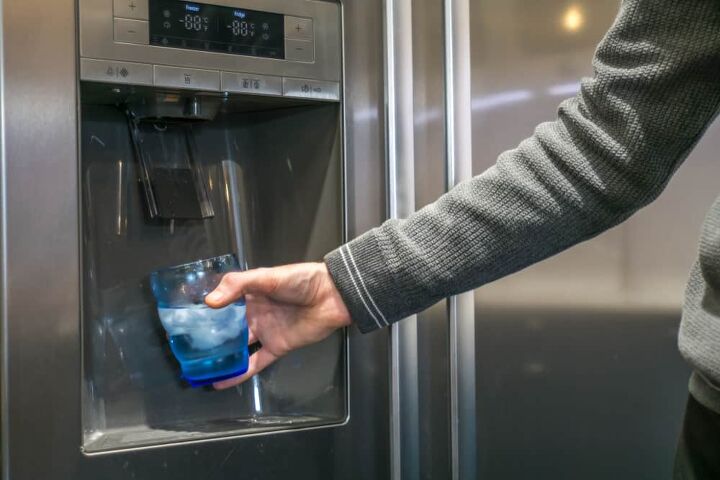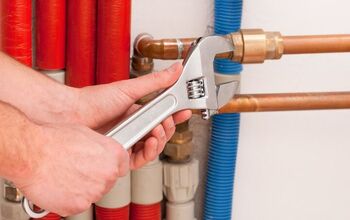LG Fridge Leaking Water From Door? (Possible Causes & Fixes)

LG is one of the most recognizable brands of appliances on the globe. Washers, dryers, stoves, dishwashers, and refrigerators are just a few of the appliances that they produce on a regular basis.
From time to time, your LG fridge may start leaking from the door. Nine times out of 10, the culprit is the ice maker or water dispenser. There are other water-related issues like the water filter or a clogged or frozen defrost drain. It is important to inspect all of the most likely culprits to find the potential problem.
Do You Need Appliance Repair Services?
Get free, zero-commitment quotes from pro contractors near you.

Do Not Ignore the Issue
Regardless of the issue, it is important that you do not ever ignore a leak. Leaking water is clearly indicative that there is something wrong with the fridge itself. That problem can potentially spread to other areas of the fridge if left unchecked.
Moreover, water can pool and puddle underneath the fridge. When water is allowed to sit unchecked, it can potentially damage the flooring underneath. Ignoring a leak can lead to far more costly issues down the line that could have easily been avoided.
Refrigerator Door Ice Maker
The ice maker in your LG fridge is one of the most likely culprits for that leaking you see coming from the door. There are a few different things that you will want to look for when inspecting your fridge door for leaking issues.
Check the crack. Like any machine, the ice maker will have some flaws inherently built-in. Even if the body itself is durable and resistant, the parts within can become susceptible to damage through mishandling or continuous use. Water can seep into the cracks in these problem areas and drip down to the floor.
Check the filter. It is entirely possible that the water filter can become torn if it isn’t changed in the designated time frame (usually 6 months). If you notice leaking coming from the door, the water filter is the first place to look. Should the filter be cracked or damaged, replace it entirely. It can also be as simple as the filter being fitted improperly. If you don’t notice any damage, pop the filter out and check to make sure that the gaps are closed.
Check the water tank. Though this is not necessarily a common issue, the water tank can get broken over time. When that happens, water can flow down into the gaps in the door. The only thing to do when you find a cracked tank is to replace it entirely. The tank itself is not repairable.
Ice Maker Bin Position
Sometimes the simplest explanation is the right one. Should you notice water leaking out of your LG fridge door, it could be that the ice maker bin is simply out of position. The spray when creating ice cubes can overshoot the tray, splashing into the catch bin and elsewhere.
Make sure that your ice bin is in the proper position before moving on to further troubleshooting. It’s a simple, but effective fix.
Water Filter Head/Housing
Though it is stated that you should check the water filter in the above section, there are different components within the water filter to be aware of. By inspecting each of these components, you can narrow down the problem and possibly even cut down on the replacement or repair costs.
Filter head. In some instances, the water filter head could be cracked or damaged. It may also be possible that the seal has become torn or is missing entirely. Take a look at the housing and the head for any cracks. Should you notice damage, replace the head entirely.
Filter housing. Much like the filter head, the housing can become cracked or damaged over time. Should you notice any cracks in the housing, it cannot be repaired. Replace it entirely with a new housing.
Water inlet valve. The inlet valve is what opens to supply water to both the ice maker and the dispenser. Should the inlet valve get stuck, have a loose fitting, or become damaged, water can then leak out of the valve. Take a look at the inlet valve to make sure that it is secured and in working order.
Check for Loose Connections
Should you get through each of the problem areas listed above and still notice leaking, there is one more place to check. Inspect all of the other components to ensure that any of the connections are properly secured.
The ice maker in particular works by receiving uninterrupted water flow from your water supply. When the valve is not turned properly, you will notice that not only has control over water flow been lost, but leaking will likely occur. Simply tightening valves and screws can be the easiest fix in the event of a leak.
Other Potential Leaking Areas
While it is certainly possible for water to leak from the door of your LG fridge, it is not necessarily the only place that you will notice a leak. There is a possibility that other components within the fridge can break or become loose, causing leaking to occur.
As is the case with all of the components in the door, it is important that you do not ignore a leak under the fridge. Address the issue immediately to prevent further water damage from occurring.
Water Pan
The water pan is actually located at the bottom of the fridge. Water gets drained and eventually falls down into the water pan. The reason that you do not need to empty it when working properly is due to the condenser.
Hot air gets blown by the condenser and eventually evaporates the water in the pan. When there are leaks, the water pan can become overrun, leading to water on the floor. It can also be as simple as the pan being damaged or cracked. Should the pan be defective, replace it entirely.
Do You Need Appliance Repair Services?
Get free, zero-commitment quotes from pro contractors near you.

Where is the Defrost Drain/Water Pan on an LG Fridge?
The drain pan is at the bottom of your LG fridge, under the freezer. In most instances, it won’t work properly if there is a crack. But the drain pan can also become clogged or excessively dirty over time, resulting in the overflow of water.
Give the drain pan a good inspection to ensure that it is working properly.
Water Drainage System
The water that runs into the ice maker goes through a drainage channel. That channel then reaches the drainage pan and will, for the most part, evaporate almost instantly. But when the temperature is too cold, that drainage channel can become blocked with ice or frozen entirely.
Turn your system off so that you can manually melt down the ice that can build up in the system. Even if you think the ice has been successfully melted, it may not be entirely thawed.
Should you still see leaking, pour a little bit of hot water down into the pipes to open them up even further. You can even use a turkey baster that is filled with hot water to force water into a clogged drain. Keep doing it as many times as necessary to free the blockage.
Drain Screens
On the inside of your LG freezer, generally closest to the back wall, there are a few different drains for the water that comes from the melted frost of the freezer. Each of these drains has a covering, generally a small screen or even a plastic grill.
From time to time, those coverings can get clogged up, primarily with dust, dirt, and food debris. Make sure that you clean the freezer component as thoroughly as you can. Make sure that they are both clean and dry before turning the freezer back on again.
Water Pressure
There is a chance that the leaking you are encountering has more to do with an external component, not necessarily the door itself. Water pressure can play a factor in water leaking out of the fridge and down onto the floor.
When the pressure is high enough, it can cause water to spill into the bottom of the freezer. Too much pressure can also loosen the inlet valve, leading to water leaking out around the valve itself. It is a good idea to have less pressure in the line. Lesser pressure will prevent splashing in the fridge and freezer, which reduces spillage and leaking as well.
Related Guides

Ryan Womeldorf has more than a decade of experience writing. He loves to blog about construction, plumbing, and other home topics. Ryan also loves hockey and a lifelong Buffalo sports fan.
More by Ryan Womeldorf












![The 5 Best Angle Grinders – [2022 Reviews & Buyer's Guide]](https://cdn-fastly.upgradedhome.com/media/2023/07/31/9071326/the-5-best-angle-grinders-2022-reviews-buyer-s-guide.jpg?size=350x220)






![Cost To Drill A Well [Pricing Per Foot & Cost By State]](https://cdn-fastly.upgradedhome.com/media/2023/07/31/9074980/cost-to-drill-a-well-pricing-per-foot-cost-by-state.jpg?size=350x220)







